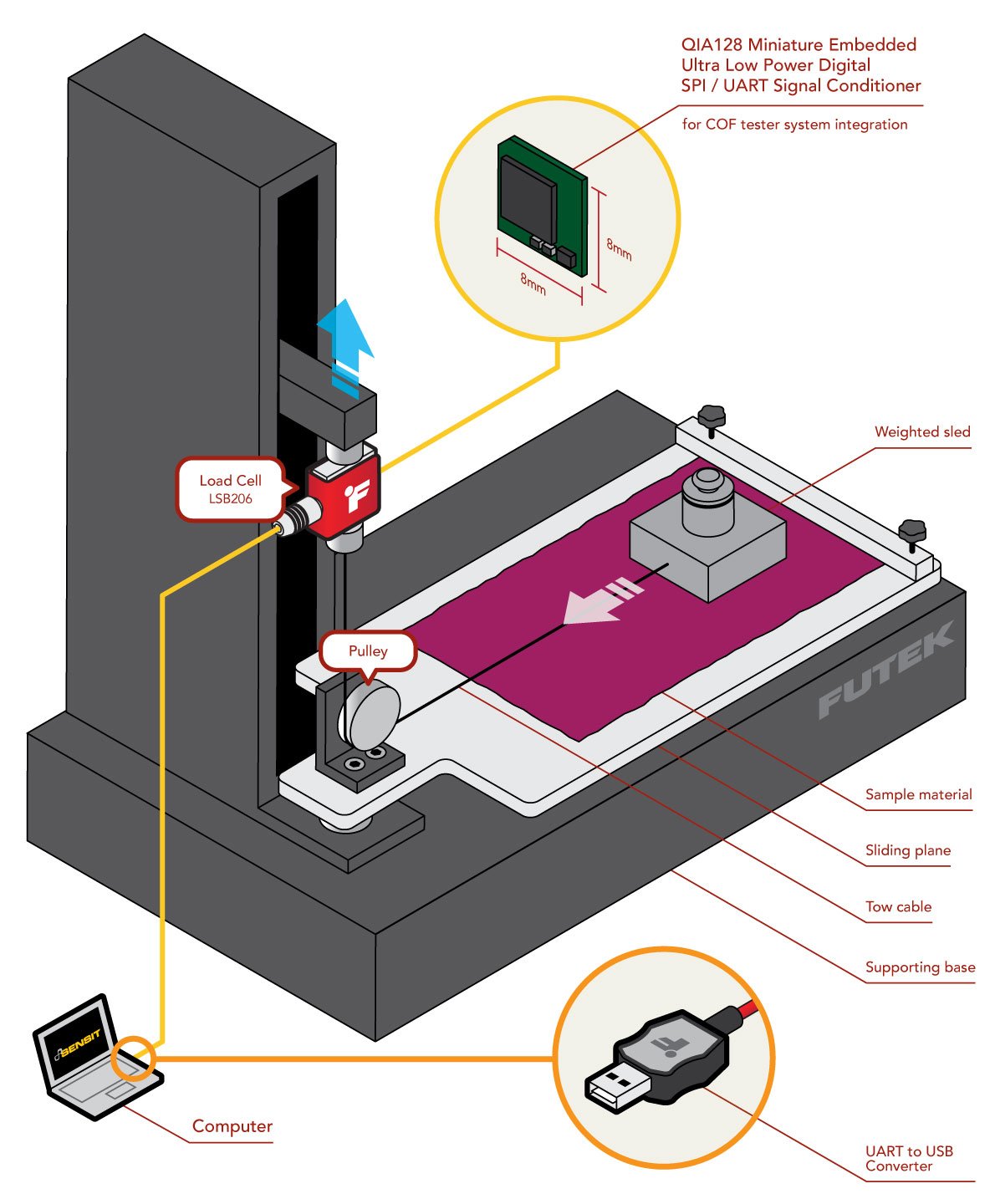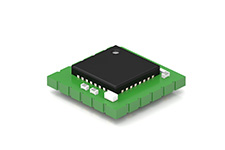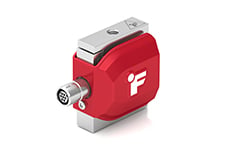What is the Coefficient of Friction (COF)?
Friction is one of the first physics principles one learns at school and it is defined as the force resisting the relative motion of solid surfaces, fluid layers, and material elements sliding against each other. By definition, the Coefficient of Friction (COF) is a dimensionless number and is calculated as the ratio between the frictional force resisting the motion of two objects and the normal force pressing the two objects together.
What is coefficient of friction testing?
The coefficient of friction (COF) tester is designed to measure the static and kinetic coefficients of friction of plastic film, plastics textile, sheeting, coated metals, leather printed cartons, packaging substrates, paper, and other surfaces.
How do you perform coefficient of friction testing?
The COF tester principle of operation consists of a fixed horizontal table or plane, and a moveable sled. A cable attaches the sled to the load cell through a pulley that guides the tow cable during the test. As the towed sled moves across the test sample, the friction force is captured by the load cell and data is recorded for post analysis to determine both static and kinetic friction. The coefficient of friction is defined as the recorded force divided by the mass of the sled.
Why is FUTEK LSB206 load cell series suitable for Friction Testing?
FUTEK LSB206 Digital Miniature S Beam load cell can accurately measure static and kinetic friction forces while maintaining a nonlinearity of ±0.1% of load cell capacity.
The LSB206 Miniature Load Cell offers a uniquely designed built-in 10x overload protection in both directions, tension and compression with capacities ranging from 1 lb to 100 lbs. The model has M3x0.5 female threads, flexure is made in 17-4 SS and the enclosure is made of stamped aluminum. LSB206 offers two cable options: 7 Pin Nano connector for easy disconnect or a cable version with mechanical strain relief.
For embedded OEM applications, the most likely option is SPI or UART output. LSB206 provides signal conditioning for embedded applications to plug in directly into your system. Our software team developed packages to support such developments and data capture. If you want to read the sensor data on a laptop, LSB206 offers a UART to USB adapter.
In conjunction with the sensor and signal conditioner, SENSIT SOFTWARE is a tool that allows engineers and operators to collect and analyze friction testing data. It can be used to graph test results, for instant creation of COF profile curves.
Why is FUTEK QIA128 embedded digital signal conditioner well suited for Friction Testing applications?
When performing friction testing to the ASTM D1894 testing standard it is essential to use a test device with not only a reliable and high precision force sensor, but also a high data capture rate. Because test events can happen quickly, a coefficient of friction test with a low data sampling rate data may skip key peaks and troughs in the data, leading to an inaccurate average static or kinetic friction value.
Industry standards compliance
- ASTM D1894-14 Standard Test Method for Static and Kinetic Coefficients of Friction of Plastic Film and Sheeting
- ISO 8295 Coefficient of Friction Plastic Film and Sheeting
- ISO 15359:1999 Paper and board - Determination of the static and kinetic coefficients of friction - Horizontal plane method
How it Works
A cable attaches the sled to the load cell thru a pulley that guides the tow cable during the test.
As the towed sled moves across the test sample, the friction force is captured by the LSB206 load cell and data is recorded for post analysis to determine both static and kinetic friction.
FUTEK QIA128 Miniature Embedded Low Power Digital Signal Conditioner with SPI / UART output reads friction force data up to 1300 SPS, to ensure all test important events and data points are captured.
Alternatively, the data produced by this test stand can be viewed on a local digital display, such as FUTEK's SENSLOG Handheld Display or IPM650 Panel Mount Display, or streamed directly to a PC using FUTEK's USB Solutions.
If more detailed data is required, utilizing FUTEK's SENSIT™ Test and Measurement Software allows operators the ability to live graph and log all data collected.
Products in Use
- LSB206: Digital S-Beam Load Cell with SPI, UART and/or USB Output
- QIA128: Miniature Embedded Low Power Digital Signal Conditioner with SPI / UART output
Contact Us
Please Contact Us with questions.
What is the Coefficient of Friction (COF)?
Friction is one of the first physics principles one learns at school and it is defined as the force resisting the relative motion of solid surfaces, fluid layers, and material elements sliding against each other. By definition, the Coefficient of Friction (COF) is a dimensionless number and is calculated as the ratio between the frictional force resisting the motion of two objects and the normal force pressing the two objects together.
What is coefficient of friction testing?
The coefficient of friction (COF) tester is designed to measure the static and kinetic coefficients of friction of plastic film, plastics textile, sheeting, coated metals, leather printed cartons, packaging substrates, paper, and other surfaces.
How do you perform coefficient of friction testing?
The COF tester principle of operation consists of a fixed horizontal table or plane, and a moveable sled. A cable attaches the sled to the load cell through a pulley that guides the tow cable during the test. As the towed sled moves across the test sample, the friction force is captured by the load cell and data is recorded for post analysis to determine both static and kinetic friction. The coefficient of friction is defined as the recorded force divided by the mass of the sled.
Why is FUTEK LSB206 load cell series suitable for Friction Testing?
FUTEK LSB206 Digital Miniature S Beam load cell can accurately measure static and kinetic friction forces while maintaining a nonlinearity of ±0.1% of load cell capacity.
The LSB206 Miniature Load Cell offers a uniquely designed built-in 10x overload protection in both directions, tension and compression with capacities ranging from 1 lb to 100 lbs. The model has M3x0.5 female threads, flexure is made in 17-4 SS and the enclosure is made of stamped aluminum. LSB206 offers two cable options: 7 Pin Nano connector for easy disconnect or a cable version with mechanical strain relief.
For embedded OEM applications, the most likely option is SPI or UART output. LSB206 provides signal conditioning for embedded applications to plug in directly into your system. Our software team developed packages to support such developments and data capture. If you want to read the sensor data on a laptop, LSB206 offers a UART to USB adapter.
In conjunction with the sensor and signal conditioner, SENSIT SOFTWARE is a tool that allows engineers and operators to collect and analyze friction testing data. It can be used to graph test results, for instant creation of COF profile curves.
Why is FUTEK QIA128 embedded digital signal conditioner well suited for Friction Testing applications?
When performing friction testing to the ASTM D1894 testing standard it is essential to use a test device with not only a reliable and high precision force sensor, but also a high data capture rate. Because test events can happen quickly, a coefficient of friction test with a low data sampling rate data may skip key peaks and troughs in the data, leading to an inaccurate average static or kinetic friction value.
Industry standards compliance
- ASTM D1894-14 Standard Test Method for Static and Kinetic Coefficients of Friction of Plastic Film and Sheeting
- ISO 8295 Coefficient of Friction Plastic Film and Sheeting
- ISO 15359:1999 Paper and board - Determination of the static and kinetic coefficients of friction - Horizontal plane method




